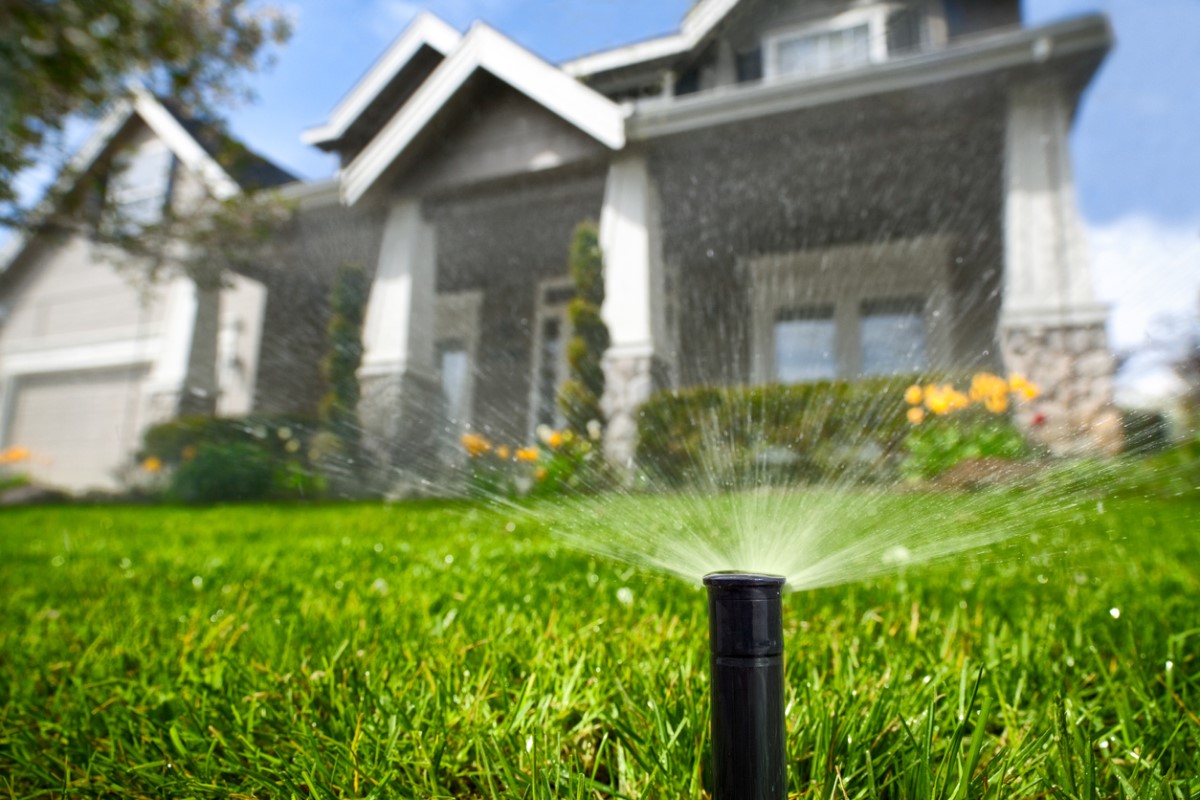We may earn revenue from the products available on this page and participate in affiliate programs. Learn More ›
Q: The brown grass in my yard seems to indicate that I’m under-watering it. How long should I run my sprinklers when I water the lawn?
A: A sprinkler system can water your lawn evenly, efficiently, and effortlessly, but the health of your turf depends on how long you run the water. Under-water by running your sprinklers too briefly and the grass will curl up and brown; overwater by leaving sprinklers on too long and the soggy ground will invite excess thatch, pests, and/or fungus while wasted water will run off and weather your hardscape.
The ideal watering duration for your lawn depends on a variety of factors, including grass type, season, sprinkler system, and weather. Read on to learn exactly how long to water your lawn for a healthy, vibrant turf.

RELATED: 11 Ways You’re Accidentally Ruining Your Lawn
How Long Should You Water Your Lawn? 7 Tips for Lawn Watering
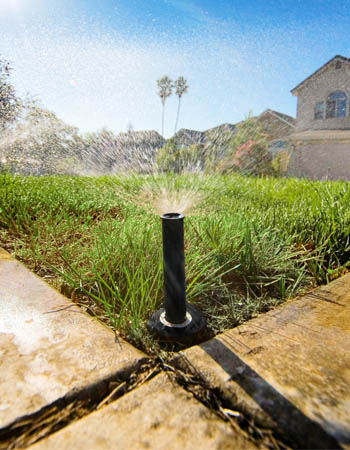
Lots of factors go into determining how long you should water your lawn. Among these are the grass type, your climate, how often you water, how you water the lawn, and more. So, to answer “how long should I water my lawn,” it helps to first gather a little data and review the info below.
1. Determine your lawn’s weekly watering needs.
First, learn how much water, in inches, your lawn needs a week. Most require an average of 1 to 1½ inches weekly, but specific watering needs vary by turfgrass type (cool season versus warm season), the specific grass, and time of year (active versus dormant growth season). Check with your local Cooperative Extension Service office for precise weekly watering recommendations for your turf and locale.
Cool-Season Grass vs. Warm-Season Grass
In general, cool-season grasses need more water than warm-season grasses, and watering needs are higher in the active season (spring and fall for cool-season grass, mid- to late spring through early fall for warm-season types) than in the dormant season (winter for cool-season and warm-season).
Cool-season Kentucky Bluegrass, for example, needs (on average) 1½ to 2 inches per week in the active season and ½ inch per week in the dormant season. In contrast, warm-season Bermudagrass needs only 1 to 1¼ inches of water weekly in the active season and only ⅛ inch per week in the dormant season. And again, depth depends on how often you water, your soil type, and general climate.
RELATED: Our Favorite Lawn Sprinkler Is Designed to Fit Any Lawn Shape or Size
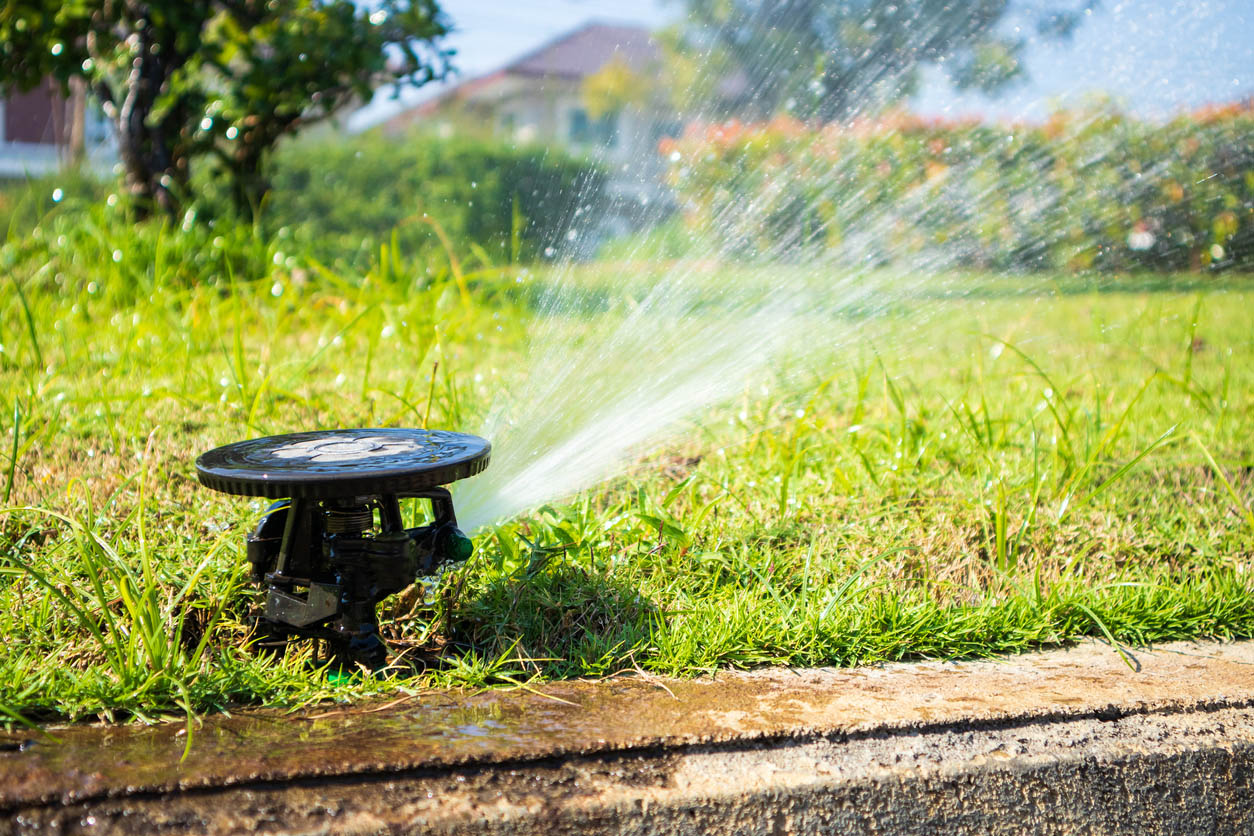
2. Figure the water output of your sprinkler system.
To calculate how much water your sprinkler system puts out per hour, place six straight-sided containers of the same size and shape in one area of the lawn where your sprinklers hit and run your sprinklers for 20 minutes. Measure the depth of water (in inches) in each container with a ruler and calculate the average depth across the containers.
Multiply the depth by three to figure out how many inches of water your sprinkler system puts out per hour. For example, if the containers each had ⅓, ¼, ¼, ¼, ¼, and ⅕ inches of water, the average water depth would be ¼ inches, and your sprinkler’s water output would be 1½ inches per hour (¼ X 6).

3. If in doubt, use the tuna can method or a flow timer.
In similar fashion, place two empty tuna cans in two different spots the lawn sprinklers hit. Run the sprinklers for 15 minutes. Using a ruler, measure the water depth in each can and take the average of the two measurements. This handy chart from Water Use it Wisely can help you convert the average into how long to water to reach an inch.
You can add a flow timer to your sprinkler line, which senses the flow and tracks actual use for a historical record. Flow sensors track irrigation in a system and can send a signal to the control box to correct the flow. Many irrigation systems with timers also offer smart sensors or rain sensors (to interrupt a watering schedule after or during rain), as do some flow timers you can place in your hose line (like this one from Amazon).

4. Calculate how long to water the lawn with your sprinklers each week.
To figure out how long your sprinklers should run each week, divide your lawn’s weekly watering needs in inches by your sprinkler’s hourly water output. For example, if your Bermudagrass lawn needs 1 inch of water weekly, and your sprinkler’s water output is 1½ inches per hour, you would need to run your sprinklers for ⅔ hours, or about 40 minutes per week on average (1 / 1½).
RELATED: The Best Things You Can Do for Your Lawn
5. Divide weekly sprinkler duration by weekly watering frequency to calculate how long to run your sprinklers each watering session.
To grow a healthy lawn, water must reach and be fully absorbed by the grass roots, which requires watering often enough to suit your lawn’s soil type. If you water only once a week, you could wind up with soggy soil that invites pests and rot. Water daily, and the water may only reach the top of roots, yielding short roots and a dry turf.
In general, clay and loamy soil store water longer but absorb it more slowly, so water lawns with these soil types one to three times per week. Sandy soil absorbs water faster but doesn’t store it as long, so water two to four times weekly.
To determine how long to run your sprinklers during each watering session, divide the total weekly sprinkler duration by the weekly watering frequency. If you need to run your sprinklers 40 minutes per week to meet your watering needs, and plan to water your lawn twice a week, set your sprinkler to run for 20 minutes each watering session (40 divided by two). Space watering sessions at least a few days apart to allow the grass roots to absorb water and breathe.

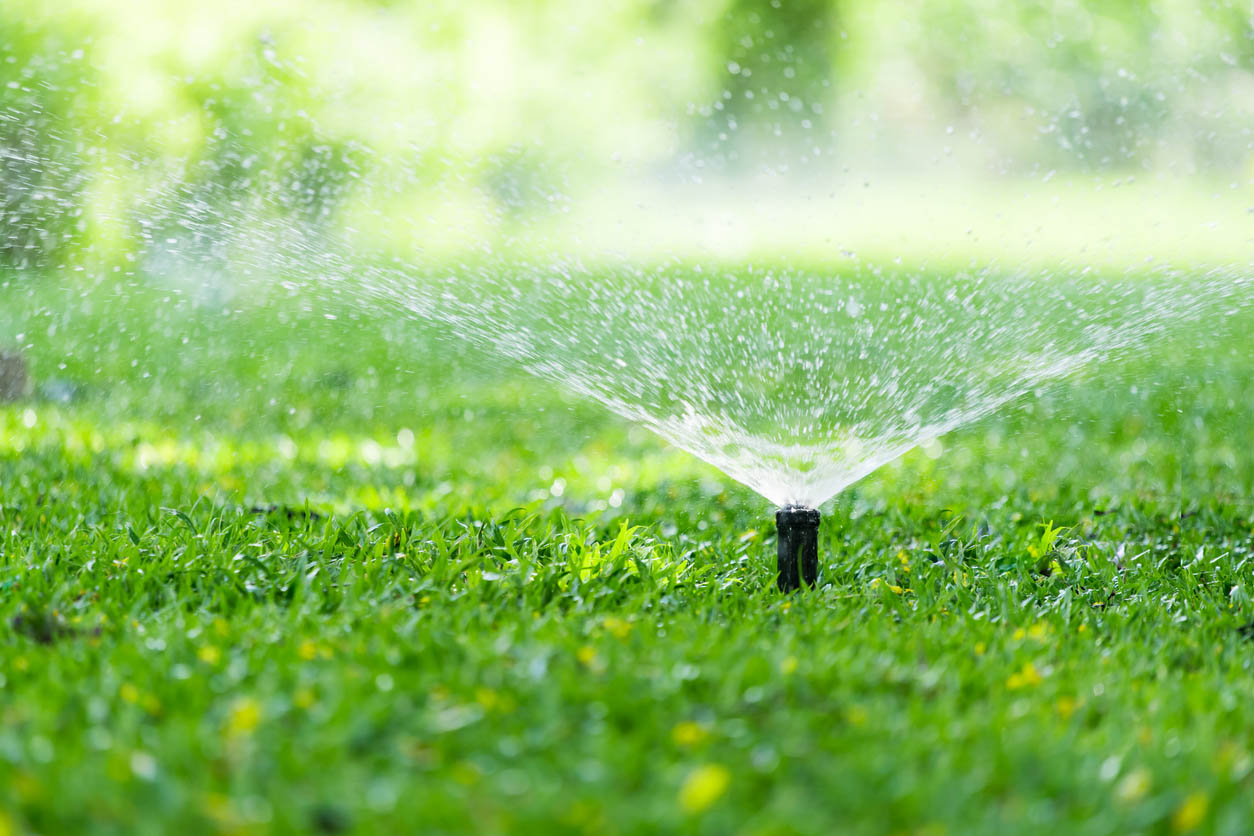
6. To save water (and money), water at the right times.
If sprinklers run in the peak heat of a summer day, much of the water the lawn craves evaporates before it even hits the ground. This depends on the day and dryness of the air, plus wind speed, which can drift sprayed water away from its intended turf target. According to the Environmental Protection Agency (EPA), about half of the water used outdoors goes to waste because it evaporates, blows in the wind, or pools and runs off the turf when applied too heavily.
Of course, evaporation is worse in dry climates (where the water is scarcest!). In any community, the best time to water grass is early morning, typically between 6 a.m. and 10 a.m. Many cities have ordinances requiring residents to water only during early morning and evening hours. Less evaporation occurs as evening sets in, but winds might be higher than near dawn. Plus, a watered lawn sitting damp all night might lead to fungal diseases of turf.
7. Adjust the math to account for rainfall.
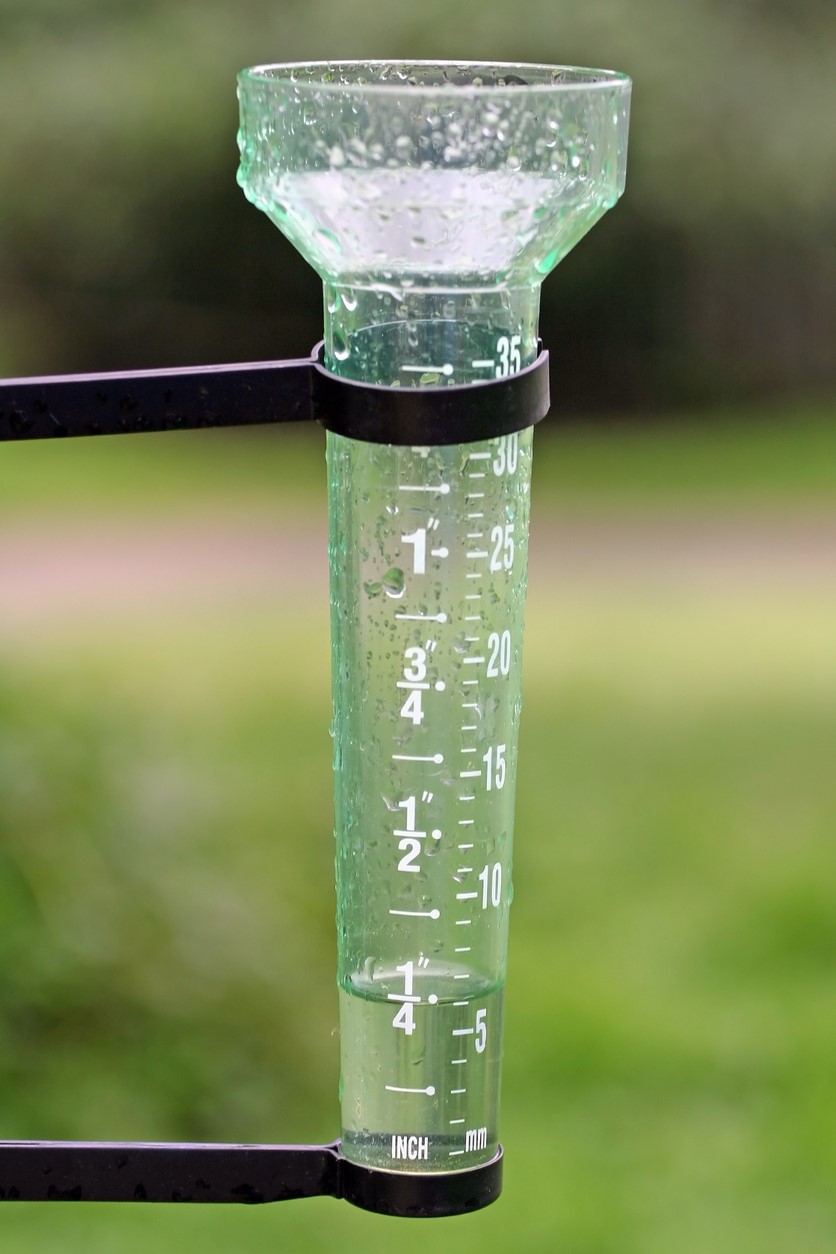
The calculations above will tell you how long to run your sprinklers in an average week with no rainfall. But natural rainfall reduces the need for supplemental irrigation. To figure out how long to water your lawn during a week when it rains, subtract the number of inches of rainfall from the weekly watering needed to get a new figure and do the rest of the calculations normally.
So if your normal weekly watering need is 1 inch of water, but you get a ½ inch of rain one week (as measured with a weather station or rain gauge, which you can pick up on Amazon), your watering needs for that week are only ½ inch of water. If your sprinkler output is 1½ inches per week, your sprinklers should run for only ⅓ hour or 20 minutes that week (½ divided by 1½). On a twice-weekly watering schedule, run your sprinklers 10 minutes each time.
FAQ About Watering Grass
Can you overwater grass?
Yes, if the turf never dries between watering, the moisture can choke out oxygen. Watering too heavily can wash away soil nutrients or cause water to pool in low spots, which is bad for the lawn and your water bill. Water less often for a little longer and watch for signs of overwatering or fungal activity.
How can you tell if you’ve watered your lawn enough?
If you have a lawn, you ought to enjoy it, so step on the grass; if it springs back, it does not need water. Look for signs of trouble, and calculate approximate lawn watering time with one of the formulas in this article, invest in a soil moisture meter or water sensing technology, or check with your local cooperative extension office for more help if unsure.

Does grass need to be watered every day?
Knowing how often to water grass helps. Only grass seed that is getting its start in the world, should need watering every day. Once seeds, sod, or plugs are established, cut back. Established grass benefits from less frequent, but deeper watering. How often you would water a lawn depends on the grass type, heat and drought, and other factors. Bermudagrass can wait 5 to 10 days between watering and bounce right back, for example.
Can brown grass turn green again?
Most grasses go dormant in winter, and begin to green up with rain and heat as spring comes along. So, water browning grass deeply in most instances and it should turn green again during its season. Wait and see how it recovers before throwing more water at the problem. Some browning, especially in circles, actually can indicate fungal growth, and adding more water will make the situation worse.
Final Thoughts
A little patch of lawn is a joy, and keeping it green and soft leaves a spot for kids and pets to run barefoot in summer. But keeping lawns green can eat up precious water and your budget.
Water lawns less often, in early morning, and deeply for the best results. Calculate how much water your grass needs to stay healthy with the tips in this article.
If the water bill still soars, invest in a flow timer or technology tool to better control watering. Or consider switching to a native grass, which should need less water and care, or downsize the patch of grass and replace some of the area with gravel and native, drought-tolerant plants.
